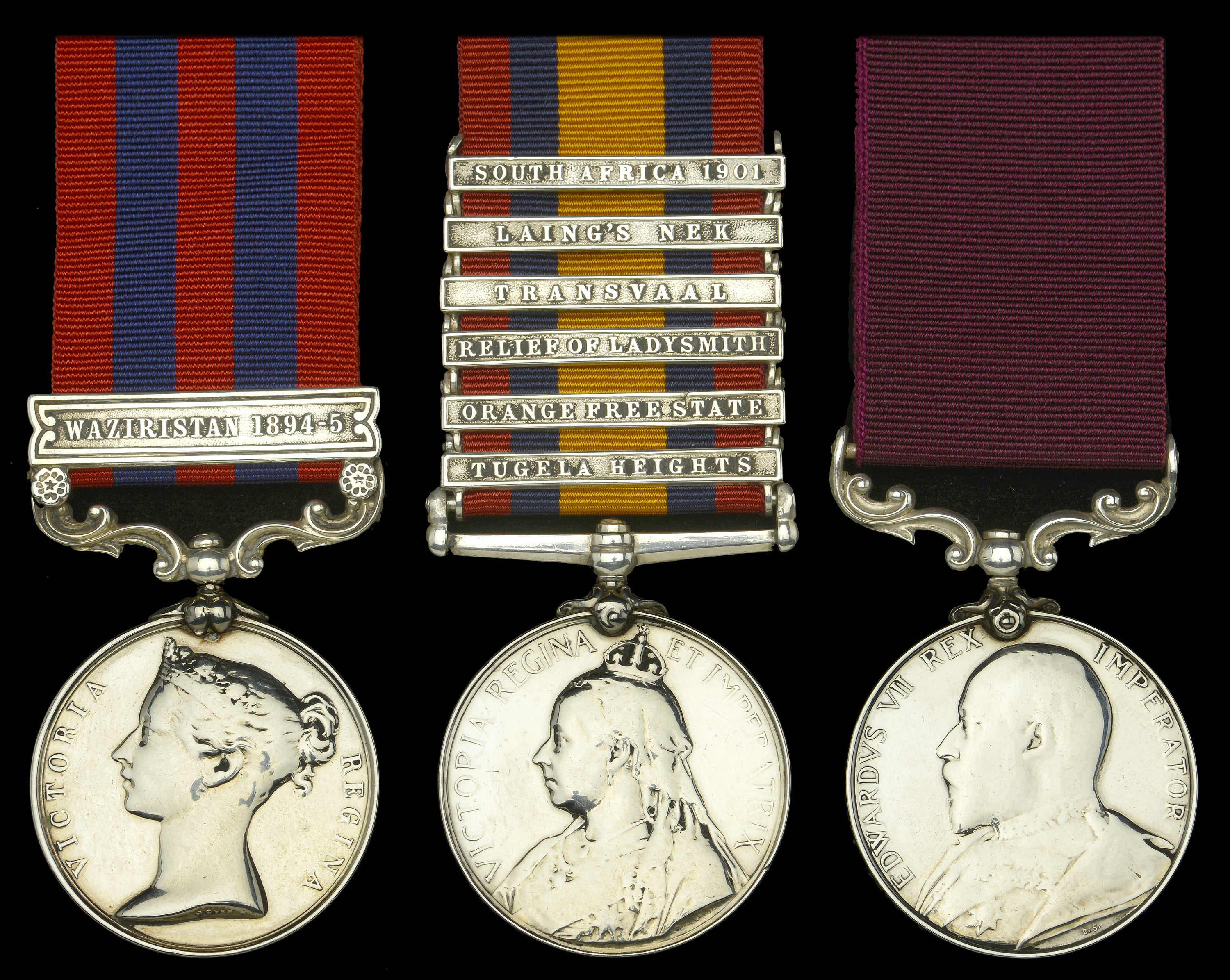123
Three: Private M. Dymond, Devonshire Regiment, who served with the Maxim Gun Detachment...
Bids do not include VAT, buyer’s premium or delivery.
By confirming your bid, you agree that you have read and accepted the-saleroom.com and the auctioneer's terms and conditions. Confirming your bid is a legally binding obligation to purchase and pay for the lot should your bid be successful.
Choose one of the quick bid options below:
Bids do not include VAT, buyer’s premium or delivery.
By confirming your bid, you agree that you have read and accepted the-saleroom.com and the auctioneer's terms and conditions. Confirming your bid is a legally binding obligation to purchase and pay for the lot should your bid be successful.
India General Service 1854-95, 1 clasp, Waziristan 1894-5 (2658 Pte. M. Dymond 1st. Bn. Devon. Regt.); Queen’s South Africa 1899-1902, 6 clasps, Tugela Heights, Orange Free State, Relief of Ladysmith, Transvaal, Laing’s Nek, South Africa 1901, unofficial rivets between fifth and sixth clasps (2658 Pte. M. Dymond. Devon: Regt.); Army L.S. & G.C., E.VII.R. (2658 Pte. M. Dymond. Devon. Regt.) polished and worn, fine (3) £500-£700
---
1 Officer and 8 Men from Devonshire Regiment served with the Maxim Gun Detachment during the Waziristan Expedition 1894-5 and received the India General Service Medal with clasp Waziristan 1894-5. The was the first occasion the machine gun was used in action by the British Army.
Mark Dymond was born at Gittisham, near Honiton, Devon in 1873. A Labourer by trade he attested for the Devonshire Regiment at Exeter on 6 August 1889 giving his age as 18 years and 4 months whereas his correct age was 16 years and 4 months. Posted to the 1st Battalion he embarked with his battalion for Egypt in January 1891 and later moving to India in January 1893 being stationed in Rawalpindi, and was part of a small detachment of 1 officer and 8 men from the 1st Battalion that formed the Maxim Detachment to join the Waziristan Expedition on 23 October 1894. Embarking for home he was transferred to Reserve 19 February 1897.
Dymond rejoined the Colours under Army Order 23 of 1898 and was posted to the 2nd Battalion at Pembroke Dock, South Wales on 22 February 1898. He embarked with the 2nd Battalion for service during the Boer War and arrived in Durban 19 November 1899. The battalion took part in the actions at Colenso, Spion Kop, Pieter’s Hill, Relief of Ladysmith and the capture of Botha’s Pass (Laing’s Nek). Wounded in action at Pieter’s Hill on 26 February 1900 he was subsequently invalided home and posted to the Depot at Exeter on 6 July 1901. Posted again to the 2nd Battalion at Devonport on 31 January 1905 he received his Long Service and Good Conduct Medal in April 1909, and was discharged after 21 years’ service to Pension on 5 August 1910.. Re-enlisting in the Devonshire Regiment for the duration of the War on 5 October 1914 he served at home until being transferred to the Royal Flying Corps as 3rd Class Air Mechanic on 23 March 1918 and classified as Batman. Subsequently transferred to the Royal Air Force Reserve he was finally discharged ‘Unfit’ on 30 April 1920. Records indicate that he had Home Service only for the Great War and therefore was not entitled to any medals. He died at Taunton on 27 December 1937, aged 65.
Sold with copied service records and other research.
India General Service 1854-95, 1 clasp, Waziristan 1894-5 (2658 Pte. M. Dymond 1st. Bn. Devon. Regt.); Queen’s South Africa 1899-1902, 6 clasps, Tugela Heights, Orange Free State, Relief of Ladysmith, Transvaal, Laing’s Nek, South Africa 1901, unofficial rivets between fifth and sixth clasps (2658 Pte. M. Dymond. Devon: Regt.); Army L.S. & G.C., E.VII.R. (2658 Pte. M. Dymond. Devon. Regt.) polished and worn, fine (3) £500-£700
---
1 Officer and 8 Men from Devonshire Regiment served with the Maxim Gun Detachment during the Waziristan Expedition 1894-5 and received the India General Service Medal with clasp Waziristan 1894-5. The was the first occasion the machine gun was used in action by the British Army.
Mark Dymond was born at Gittisham, near Honiton, Devon in 1873. A Labourer by trade he attested for the Devonshire Regiment at Exeter on 6 August 1889 giving his age as 18 years and 4 months whereas his correct age was 16 years and 4 months. Posted to the 1st Battalion he embarked with his battalion for Egypt in January 1891 and later moving to India in January 1893 being stationed in Rawalpindi, and was part of a small detachment of 1 officer and 8 men from the 1st Battalion that formed the Maxim Detachment to join the Waziristan Expedition on 23 October 1894. Embarking for home he was transferred to Reserve 19 February 1897.
Dymond rejoined the Colours under Army Order 23 of 1898 and was posted to the 2nd Battalion at Pembroke Dock, South Wales on 22 February 1898. He embarked with the 2nd Battalion for service during the Boer War and arrived in Durban 19 November 1899. The battalion took part in the actions at Colenso, Spion Kop, Pieter’s Hill, Relief of Ladysmith and the capture of Botha’s Pass (Laing’s Nek). Wounded in action at Pieter’s Hill on 26 February 1900 he was subsequently invalided home and posted to the Depot at Exeter on 6 July 1901. Posted again to the 2nd Battalion at Devonport on 31 January 1905 he received his Long Service and Good Conduct Medal in April 1909, and was discharged after 21 years’ service to Pension on 5 August 1910.. Re-enlisting in the Devonshire Regiment for the duration of the War on 5 October 1914 he served at home until being transferred to the Royal Flying Corps as 3rd Class Air Mechanic on 23 March 1918 and classified as Batman. Subsequently transferred to the Royal Air Force Reserve he was finally discharged ‘Unfit’ on 30 April 1920. Records indicate that he had Home Service only for the Great War and therefore was not entitled to any medals. He died at Taunton on 27 December 1937, aged 65.
Sold with copied service records and other research.
Orders, Decorations, Medals and Militaria
Sale Date(s)
Venue Address
General delivery information available from the auctioneer
If you are successful in purchasing lot/s being auctioned by us and opt for the item/s to be sent to you, we will use the following methods of shipment:
Within the UK
If you live within the UK, items will be despatched using Royal Mail Special Delivery. This service provides parcel tracking (via the Royal Mail website) and next weekday delivery (betwen 9am and 1pm). Items delivered within the UK are covered by our insurance company. Heavy and bulky lots will be sent by courier, in discussion with the client.
Outside of the UK
If the item/s being sent are worth under £1000 in total they are sent using Royal Mail’s Signed For International service. This ensures the item must be signed for when it is delivered.
If the item/s being sent are valued at over £1000 in total they will be sent using FedEx. This service allows next day delivery to customers in many parts of the US and parcels are fully trackable using the FedEx website.
Shipping Exceptions
Certain lots such as those containing glass or sharp implements, etc., may not be suitable for in-house shipping within or outside of the UK. Please contact Noonans with any queries.
Important Information
Auctioneer's Buyers Premium: 24% (+VAT)
There is an additional charge of 4.95% (+VAT/sales tax)










